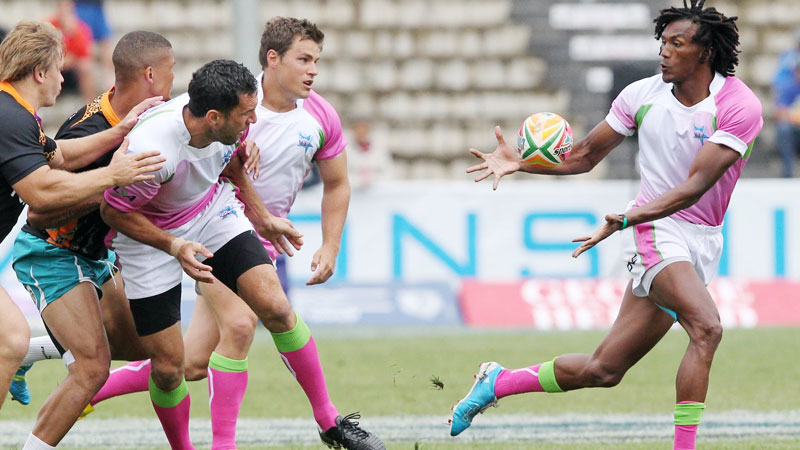Authority Soccer (authoritysoccer.com) is a participant in the Amazon Services LLC Associates Program, an affiliate advertising program designed to provide a means for sites to earn advertising fees by advertising and linking to Amazon.com. This site also participates in other affiliate programs and is compensated for referring traffic and business to them.
Soccer and rugby are two of the most popular sports in the world today. Firstly, they’re popular recreational activities, played by millions globally at every level.
They’re also fantastic to watch live in a stadium or on TV. Many people wonder if they have any common ground. So what are the main differences and similarities between soccer and rugby?
There are some obvious contrasts between the two sports. From the numbers of players on each team to the shape of the ball that they play with, these are very clear.
However, they also share a lot that may surprise you. For a start, both sports originated in the United Kingdom and are field games.
Meanwhile, they involve getting a ball from one side of the field to the other while protecting your area. Even when these sports appear different, similarities arise, like in the offside rule and penalty shootouts.
Let’s take a look at ten differences and ten differences between these two sports.
Differences Between Soccer and Rugby

1. One Ruleset vs. Two
Soccer follows a single ruleset across the globe. Every professional team must have eleven players on the field.
This never changes regardless of continental governing bodies or competition.
In contrast, there are two types of rugby. Rugby Union is the most popular and uses 15 players. Meanwhile, Rugby Union is a faster sport with 13 players.
2. Hands vs. Feet
Soccer players must not handle their spherical ball when it is in play. The only exception to this rule is the goalkeeper, but even he can’t pick up the ball when his player passes to him.
On the other hand, rugby players primarily use their hands to throw their oval-shaped balls at each other. Kicking is permitted but it is a secondary option.
3. Scoring System
Anybody who watches the two sports can see a difference in the goalframes. The scoring system in soccer is simple: put the ball in the net and score a goal.
Rugby is more complicated. Players have to touch the ball down on the opponent’s side of the field to score a try. This is worth five points.
They can also score by kicking the ball between the posts and this is worth either three or two points, depending on the circumstances.
4. The Goalkeeper

Every soccer team must have a goalkeeper in their starting lineup. This player can use their hands and feet to block the ball within their zone on the field.
Rugby doesn’t have a fixed goalkeeper because they have an entire line to protect. The closest similar position is the fullback who starts attacks and is the last line of defense.
5. Physicality
Both sports are very physical but rugby takes a tougher toll on its athletes. Players throw themselves into tackles and don’t complain.
The same level of aggression is unacceptable in soccer. Also, soccer players are notorious for feigning or exaggerating injuries to gain an advantage. This would never happen in rugby because the player would become a pariah.
6. Respect
Referees and officials receive much more respect from rugby players than their soccer players. Firstly, the captain is the only member of the team who is allowed to speak to the referee.
It’s common to see entire soccer teams swarm around the referee when they don’t like a decision. This is a smart rule in rugby because it has created a culture of respect.
7. Sin Bin
Yellow cards feature in both sports. When a player receives two, they must leave the field. However, a single yellow card has a profound impact on rugby.
This means a player must sit out for ten minutes, while the game continues without them or a replacement.
It’s common for opposition teams to score when players are sin-binned. Many soccer fans think that their sport would benefit from this system.
8. Global Domination
While some European nations like England and France are competitive in both sports, other countries dominate.
Brazil has five FIFA World Cups to their name but makes no impression in rugby. The same can be said of New Zealand, whose All-Blacks are the most famous team in the sport.
Meanwhile, rugby fans revere the Pacific Islands for producing some of the best talents for their teams.
9. High Scoring v Low Scoring
The nature of the two team’s scoring systems means that there is a big difference between their final scores.
It’s common for rugby teams to go deep into double digits. When teams finish the game with less than ten points, they have played very poorly.
But if a soccer team loses by a margin of five or six goals, this is a very heavy loss. The pace of the games is very different because of these rulesets.
10 . No Forward Passes
Both sports require the ball to go from one side of the field to the other. However, rugby players are unable to throw the ball forward.
Instead, they gradually move up the field as a collective, passing the ball back until one player rushes free or kicks upfield. Soccer doesn’t have any restraints like this.
Similarities Between Soccer and Rugby

1. Origin
Soccer and rugby were more or less the same game until 1839 when the first rugby rules were clearly defined.
Before this, both teams used round balls and were referred to as ‘football’ in the United Kingdom.
Over time the two sports diverged dramatically from each other.
2. Creative Hub
Both sports rely on a creative player who acts as a conduit for the rest of the team. In soccer, this takes the form of a creative midfielder who sprays passes around the field.
Rugby uses a flyhalf whose role is very similar to the quarterbacks in NFL. Flyhalves and creative soccer players also receive a lot of adulation from the fans.
3. Playing Field
Soccer and rugby share the fact that they take place on a playing field or pitch. The dimensions of the field are slightly different but each team tries to protect their half while attacking the other side.
They also have markings on the field for different moments of the game.
4. Penalty Shootouts
It’s the most dramatic way to finish a football match, but did you know that penalty shootouts also occur in rugby?
It’s extremely rare, but when a knockout game ends with the same score after extra time, it goes to a shootout.
Every player tries to kick the ball between the posts until somebody misses. It’s agonizing to watch but incredibly entertaining.
5. World Cup
On an international level, the pinnacle of both sports is their respective World Cups. These take place every four years and see the best countries in the world compete for glory.
While the Rugby World Cup is a smaller scale tournament than its soccer equivalent, it’s still very entertaining and massive for the countries involved.
6. Games of Two Halves
Rugby games last for eighty minutes and are divided into two 40 minute halves. Meanwhile, soccer games are 90 minutes with additional extra minutes in each of their halves.
Both see the teams swap sides at the end of the half. This can be an advantage or problem depending on the weather because of the wind or sun.
7. Injury Time
Usually, games in both sports go into overtime. In soccer, the referee adds a few extra minutes to make up for time lost because of injuries or substitutions.
Meanwhile, in rugby, play continues after 80 minutes until the ball goes dead. The referee won’t stop the game until an error occurs or the ball leaves the field.
8. Attack and Defense

These are team sports so everybody on the field has a role. Different body types are required for these roles.
For example, center-backs in soccer are typically broader and stronger than attacking players. Furthermore, in rugby, the props are gigantic men with broad frames.
Their appearance is very different from the wingers, who are the most agile players on the field.
9. Video Referee
Video replays are a key part of both sports in the modern era. In rugby, the referee may call on the Television Match Official (TMO) to check moments of controversy.
These could be disputed tries or a potential foul. In soccer, the Video Assistant Referee fills a similar role.
The main difference between the two is that rugby referees wear a microphone so everybody can hear their rationale at the time.
10. Offside Rule
In soccer, it is illegal to pass to one of your players if they are standing beyond the last opposition defender. At this point, they are in an offside position.
However, if they burst past the defender after the ball leaves the passer’s foot, this is fine. We talked about how rugby players can’t throw the ball forward. While this is a difference between the two sports, it is also an offside rule.

